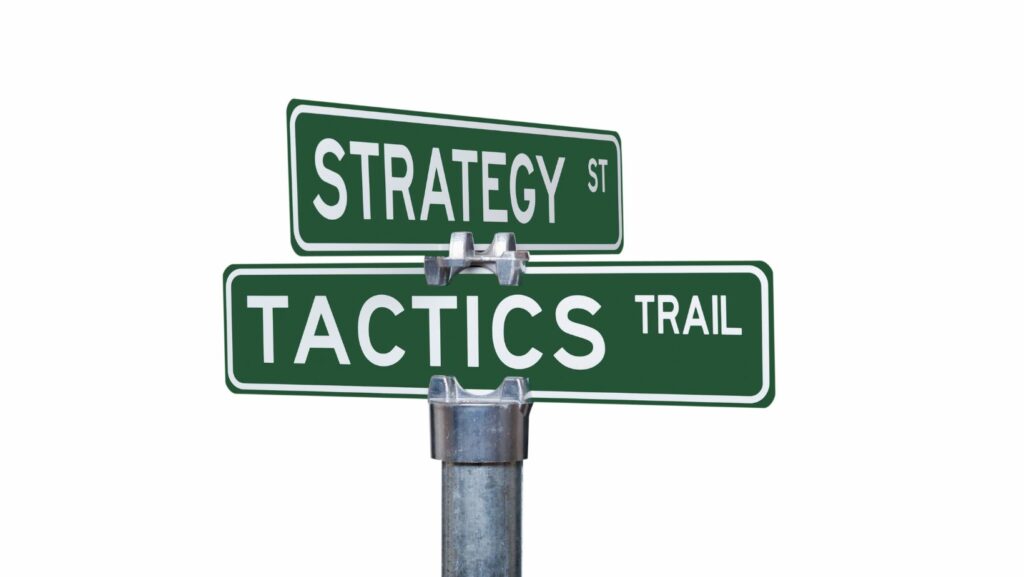In the world of business and warfare, two terms often get thrown around: tactics and strategy. They’re not just buzzwords, they’re the backbone of any successful operation. But what’s the real difference between the two?
Strategy is the big picture, the long-term game plan. It’s the overarching vision that guides all decisions. Tactics, on the other hand, are the nitty-gritty details, the short-term moves made to achieve the larger strategic goals.
Difference Between Tactics and Strategy
Definitions and Differences
 A strategy equates to the broader, long-term plan guiding numerous decisions. It’s the comprehensive map offering a clear path towards attaining the final objectives. Essentially, a strategy outlines the overall goal and the core plan for achieving that goal. It often factors in potential obstacles, resources at hand, and realistic timelines.
A strategy equates to the broader, long-term plan guiding numerous decisions. It’s the comprehensive map offering a clear path towards attaining the final objectives. Essentially, a strategy outlines the overall goal and the core plan for achieving that goal. It often factors in potential obstacles, resources at hand, and realistic timelines.
Tactics, on the other hand, signify the short-term, on-ground details utilized to attain strategic goals. They correlate with smaller, day-to-day operations and actions that form a piece of the larger strategic puzzle. Tactics specifically outline how to use available resources to reach strategic objectives.
Real-World Examples
To better understand tactics and strategy, real-world instances provide further clarity.For example, in a business context, a company’s broad strategy might involve establishing a robust market presence by increasing its product line. For this strategy, various tactical decisions might include investing in research and development to design new products, utilizing aggressive marketing campaigns to promote these products, and providing lucrative deals to increase product adoption.
Likewise, in a military situation, a strategy might pertain to winning a war by capturing a crucial enemy base. The related tactics might involve distracting the enemy with a decoy attack, deploying special forces for the actual secret mission, and cutting off enemy reinforcements using air strikes.
Historical Perspectives on Strategy and Tactics
Military Origins
 Players in the arena of military warfare, often considered pioneers of strategy and tactics, made initial usages. In this context, strategy traditionally referred to the overarching plans for a war or battle series, taking into account variables such as geographical landscape, enemy strength, and available resources. Tactics, on the other hand, were the specific actions executed on the battlefield to achieve the larger strategic goals, involving precise maneuvers, immediate responses, and split-second decision making. Notable figures such as Sun Tzu and Carl von Clausewitz, respected for their philosophical insights into warfare strategy, substantiate this perspective with their works.
Players in the arena of military warfare, often considered pioneers of strategy and tactics, made initial usages. In this context, strategy traditionally referred to the overarching plans for a war or battle series, taking into account variables such as geographical landscape, enemy strength, and available resources. Tactics, on the other hand, were the specific actions executed on the battlefield to achieve the larger strategic goals, involving precise maneuvers, immediate responses, and split-second decision making. Notable figures such as Sun Tzu and Carl von Clausewitz, respected for their philosophical insights into warfare strategy, substantiate this perspective with their works.
Evolution Through Business and Games
As times changed, the applications of strategy and tactics evolved, reaching into business and games. The competitive aspects of these fields found resonance with the military origins of strategy and tactics. In business, strategy grew to represent the company’s long-term goals and broad plan to achieve them, considering market trends, customer behavior, competition, resources at hand, etc. Tactics became the operational tasks and short-term actions implemented daily to execute the strategic plan.
In games and simulations, strategy is the high-level plan to win, accounting for the game rules, opponent’s potential moves, and other key factors. Tactics become the actual gameplay decisions, from move sequences in chess to character selection in video games. This interpretation is evident in games of all kinds, from traditional board games like chess and poker to complex online games and simulations.
Key Characteristics of Strategy
Long-Term Planning
 Long-term planning is one characteristic that typifies strategic thinking. Often stretching years into the future, this aspect aligns organizational resources towards pre-defined goals. Take, for instance, the pharmaceutical industry, with development cycles longer than a decade, the strategy for new drug development needs a long-term plan that caters to research, clinical trials, and regulatory clearances.
Long-term planning is one characteristic that typifies strategic thinking. Often stretching years into the future, this aspect aligns organizational resources towards pre-defined goals. Take, for instance, the pharmaceutical industry, with development cycles longer than a decade, the strategy for new drug development needs a long-term plan that caters to research, clinical trials, and regulatory clearances.
Broad Objectives
Strategies tend to focus on reaching broad objectives rather than on specific tasks. Broad metrics like growth, market domination, sustainability, and innovation often form the strategic objectives of businesses. A classic example, Amazon’s early business strategy focused on achieving market leadership in online bookselling before diversifying into other product categories. Their broad objective was encapsulated in the phrase – ‘get big fast.’ This allowed them to cement their position as a leading e-commerce platform, despite the financial losses they incurred, setting the stage for vast profits in the future.

